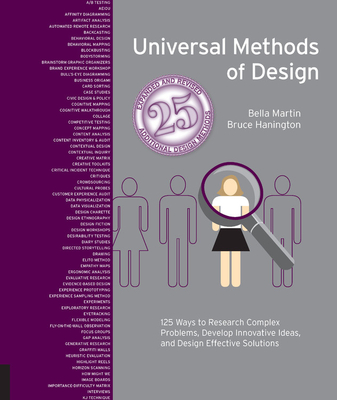內容簡介
內容簡介 This expanded and revised version of the best-selling Universal Methods of Design is a comprehensive reference that provides a thorough and critical presentation of 125 research methods, synthesis analysis techniques, and research deliverables for human-centered design. The text and accompanying photos and graphics of this classic resource are delivered in a concise and accessible format perfect for designers, educators, and students. This new, expanded edition includes updated information on scenarios, secondary research, territory maps, and other chapters. The addition of 25 new chapters brings fresh relevance to the text with innovative design methods that have emerged since the first edition, such as backcasting, behavioral design, horizon scanning, and transition design. Universal Methods of Design, Expanded and Revised distills each method down to its essence, in a format that helps design teams select and implement the most credible research methods suited to their design culture. Each method is presented in a two-page format. The left-hand page contains a concise description of the method, accompanied by references to further reading. On the right-hand page, images and case studies for each method are presented visually. The relevant phases for design application are highlighted as numbered icons along the right side of the page, from phases 1 (planning, scoping, and definition) through 5 (launch and monitor). Build more meaningful products with these methods and more: Affinity Diagramming, Behavioral Mapping, Bodystorming, Contextual Design, Critical Incident Design, Directed Storytelling, Empathy Maps, Graffiti Walls, Image Boards, Parallel Prototyping, Simulation Exercises, Touchstone Tours, and Weighted Matrix. This essential guide: Dismantles the myth that user research methods are complicated, expensive, and time-consumingCreates a shared meaning for cross-disciplinary teamsIllustrates methods with compelling visualizations and case studiesCharacterizes each method at a glanceIndicates when methods are best employed to help prioritize appropriate design research strategiesUniversal Methods of Design, Expanded and Revised is an essential resource for designers of all levels and specializations.
作者介紹
作者介紹 Bruce Hanington is a professor and head of the School of Design at Carnegie Mellon University in Pittsburgh, Pennsylvania. Prior to this, he was director of graduate studies, and program chair of industrial design. Bruce has dedicated his teaching and research to methods and practices for human centered design, with an emphasis on design ethnography, participatory design, and the meaning of form in context. In addition to working with industry partners through collaborative projects and executive education, his work has been published in Design Issues, The Design Journal, and Interactions, with chapters in Affective Sciences in Human Factors and Human-Computer Interaction and The Routledge Handbook of Sustainable Design.Bella Martin is a Lead User Experience Researcher in Atlanta, Georgia. After contributing to award-winning design projects for Microsoft Research, the US Postal Service, GlaxoSmithKline, and Allstate Financial, she now invests much of her time working with organizations who are new to the methods of user-centered research, but eager to give their users a voice in the design process. Bella holds a Master of Design from Carnegie Mellon University, where she first began her ongoing work in visualizing user-centered research methods.
